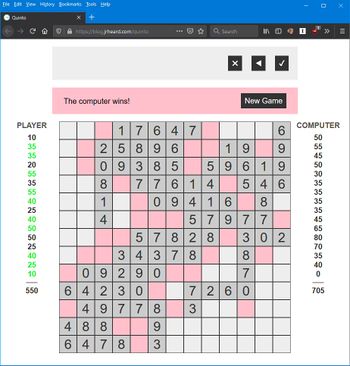Quinto (grid game)
Quinto is a two-player board game, sometimes also called "Game of Fives". It's rules resemble those of Scrabble, except the tiles are numbers rather than letters. The vertical and horizontal total must always be a multiple of five, and five is the maximum tiles that can be in a contiguous run. Each play can be horizontal or vertical, but not both. The score of each play, as in Scrabble, is the sum of all numerical totals of each vertical or horizontal run created by the play.
The original board game was sold in the 1960's by 3M (as a "3M Bookshelf" game), and is no longer being manufactured. As of 2020, a lively online trade exists in old, used Quinto board games. There are two editions being traded. The 1964 edition has 90 black tiles, and a marble-gray board with 13 rows and 17 columns. The 1968 edition has ? brown tiles and 5 red tiles[1], and a white board with 13 rows and 18 columns (one more than the 1964 game). Note that the number distributions in the two editions differs, as well as the count and color of the tiles.
The 1964 Quinto board game had 90 black plastic tiles and a gray marble board, distributed as follows:
In 2018, programmer J. R. Heard created an addictive online version of Quinto written in Javascript, so that it executes locally in your web browser. Heard provided a smart computer component that is virtually unbeatable by humans, and also play hints that help a human increase their skills. The browser game is based on the 90-tile 1964 edition of the Quinto board game, except that the board consists of thirteen rows and columns (four less vertical columns than the 1964 edition on which the game is based). The game was programmed using ClojureScript (to create Javascript, and its code details are also online.
There is also an older card game named Quinto available through online trade; it has little resemblance to the tile game.
- ↑ Unfortunately, it is unclear how the five red tiles in the 1968 edition, called "multiles", are scored.
